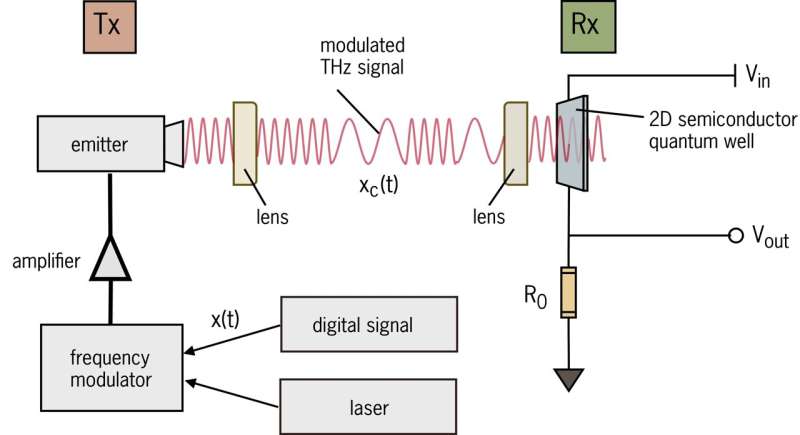August 29, 2023 dialog
This article has been reviewed according to Science X's editorial process and policies. Editors have highlighted the following attributes while ensuring the content's credibility:
fact-checked
peer-reviewed publication
trusted source
written by researcher(s)
proofread
Quantum-enhanced detection for chip-scale wireless communications

The demand for fast data sharing and processing has sparked a race for greater bandwidth in wireless communication systems. This is described by Edholm's Law, which states that bandwidth and data rates roughly double every year and a half. As our wireless networks near their limits, the quest for even faster data rates prompts researchers to explore uncharted territory: higher frequency bands like millimeter wave, terahertz and optical frequencies.
While millimeter wavelength has been adopted in short-range wireless systems, more is needed for future demands. Optical wireless communication offers high bandwidth but faces challenges due to safety regulations and noise issues. Terahertz communication could provide incredibly fast data rates for everyday applications, even chip-scale ones like integrated microprocessors.
Modern computing relies heavily on multicore processors—miniature devices containing multiple processing units. Lately, manufacturers have been improving performance by adding more processing units and making chip systems smaller. This has led to a significant increase in the number of individual computing parts in a small space, making the connections between them more complex. However, the conventional ways these parts are connected are inefficient and can slow down the system.
To address this challenge, an exciting solution emerges: using wireless communication methods that operate within the terahertz range. These methods can establish rapid and efficient wireless connections among the various components of the system. However, effectively implementing these technologies requires integrating different components for processing signals within the receiver end of the system. This involves the crucial tasks of detecting and decoding information from the transmitted signal. Moreover, aligning the receiver antenna with the specific wavelength of the terahertz carrier signal presents a difficulty in making the receiver compact.
As a result, the current approach often results in bulky, heavy, and unreliable receivers. This limitation has prompted researchers to concentrate on developing innovative receiver technologies that are not only small and lightweight but also consume less power.
Our research team has unveiled a comprehensive theoretical framework: a quantum-scale terahertz signal detector and demodulator. This innovative approach taps into the quantum behavior of charge carriers when exposed to intense periodic driving. Our findings have been published in the journal Physica Scripta.
In the realm of condensed matter physics, the use of light–matter interactions to drive quantum materials into states far from equilibrium are critical to unveiling new quantum phases that remain inaccessible in equilibrium settings. Among the commonly cited methods, Floquet engineering stands out. This technique empowers researchers to explore many novel quantum states that emerge when a system is subjected to strong, time-periodic radiation [1, 2, 3].
Thanks to Floquet engineering, we have shown that a two-dimensional semiconductor quantum well conductivity links linearly with the frequency of applied radiation within a specific range. The foundation of our findings lies in understanding that subjecting a two-dimensional semiconductor to periodic driving enhances its electrical conductivity.
This enhancement occurs due to the alteration of electron wave functions by the applied field, resulting in a reduction of electron-impurity scattering probability [4]. This discovery paves the path for a quantum wireless receiver built to detect and sort out frequency-modulated wireless data on the tiniest scale.
Harnessing this breakthrough, we have conducted numerical simulations that exhibit the feasibility of creating a quantum wireless frequency demodulator operating in the terahertz range for short-range wireless communication. Our investigation introduces a novel approach to receive and decode digitally modulated signals spanning the terahertz spectrum, achieved through the use of a mere few-nanometer-thick semiconductor quantum well based on GaAs/AlGaAs heterostructure.
The results of our research reveal an uncharted domain of extraordinary possibilities that could transform chip-scale wireless communication technology. With the potential for enhanced efficiency and streamlined design, our findings introduce possibilities for next-generation wireless devices, circuits and elements. This advancement opens the door to a diverse spectrum of applications, encompassing the advancement of wireless communication, radar, and quantum technology.
This story is part of Science X Dialog, where researchers can report findings from their published research articles. Visit this page for information about ScienceX Dialog and how to participate.
Kosala Herath is a PhD candidate and a member of the Advanced Computing and Simulations Laboratory (qdresearch.net) at the Electrical and Computer System Engineering, Monash University, Australia.
Professor Ampalavanapillai Nirmalathas is currently the Deputy Dean Research at the Faculty of Engineering and Information Technology, the lead for the Wireless Innovation Lab (WILAB) and a Professor of Electrical and Electronic Engineering.
Sarath D. Gunapala is a solid-state physicist, and senior research scientist at Jet Propulsion Laboratory (JPL) California Institute of Technology Pasadena, CA. He leads the Infrared Photonics Group at the Jet Propulsion Laboratory.
Malin Premaratne earned several degrees from the University of Melbourne, including a B.Sc. in mathematics, a B.E. in electrical and electronics engineering (with first-class honors), and a PhD in 1995, 1995, and 1998, respectively. Currently, he serves as the Vice President of the Academic Board of Monash Universi
More information: Kosala Herath et al, Floquet engineering-based frequency demodulation method for wireless THz short-range communications, Physica Scripta (2023). DOI: 10.1088/1402-4896/aceebc
1 Kosala Herath et al, Generalized model for the charge transport properties of dressed quantum Hall systems, Physical Review B (2022). DOI: 10.1103/PhysRevB.105.035430
2 Kosala Herath et al, Floquet engineering of dressed surface plasmon polariton modes in plasmonic waveguides, Physical Review B (2022). DOI: 10.1103/PhysRevB.106.235422
3 Kosala Herath et al, A Floquet engineering approach to optimize Schottky junction-based surface plasmonic waveguides, Scientific Reports (2023). DOI: 10.1038/s41598-023-37801-x
4 Malin Premaratne and Govind P. Agrawal, Theoretical foundations of nanoscale quantum devices, Cambridge University Press (2021). DOI: 10.1017/9781108634472
Journal information: Scientific Reports , Physical Review B





















